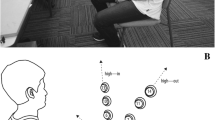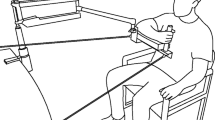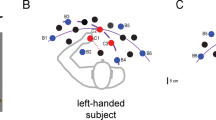Abstract
The use of arm weight support (WS) to optimize movement quality may be an avenue for improved upper limb stroke rehabilitation; however, the underlying neurophysiological effects of WS are not well understood. Rehabilitation exercises may be performed when sitting or standing, but the interaction of posture with WS has not been examined until now. We explored the effect of posture with WS on corticomotor excitability (CME) in healthy adults. Thirteen participants performed static shoulder abduction in two postures (sitting and standing) at three levels of WS (0, 45, and 90 % of full support). Transcranial magnetic stimulation of primary motor cortex was used to elicit motor-evoked potentials (MEPs) in eight upper limb muscles. Stimulus–response (SR) curves were fitted to the MEP data using nonlinear regression. Whole-body posture interacted with WS to influence tonic activity and CME in all muscles examined. SR curve parameters revealed greater CME when standing compared to sitting for upper arm muscles, but lower CME to the shoulder, forearm, and hand. Distal to the shoulder, tonic activity and CME were modulated independent of any explicit differences in task requirements. Overall, these results support a model of integrated upper limb control influenced by whole-body posture and WS. These findings have implications for the application of WS in settings such as upper limb rehabilitation after stroke.






Similar content being viewed by others
References
Allum JHJ, Carpenter MG, Honegger F et al (2002) Age-dependent variations in the directional sensitivity of balance corrections and compensatory arm movements in man. J Physiol (Lond) 542:643–663. doi:10.1113/jphysiol.2001.015644
Beer RF, Dewald JPA, Dawson ML, Rymer WZ (2004) Target-dependent differences between free and constrained arm movements in chronic hemiparesis. Exp Brain Res 156:458–470. doi:10.1007/s00221-003-1807-8
Benjamini Y, Krieger AM, Yekutieli D (2006) Adaptive linear step-up procedures that control the false discovery rate. Biometrika 93:491–507. doi:10.1093/biomet/93.3.491
Berrigan F, Simoneau M, Martin O, Teasdale N (2006) Coordination between posture and movement: interaction between postural and accuracy constraints. Exp Brain Res 170:255–264. doi:10.1007/s00221-005-0210-z
Binder MD, Heckman CJ, Powers RK (1993) How different afferent inputs control motoneuron discharge and the output of the motoneuron pool. Curr Opin Neurobiol 3:1028–1034
Bizzi E, Cheung VCK (2013) The neural origin of muscle synergies. Front Comput Neurosci 7:1–6. doi:10.3389/fncom.2013.00051
Brewer BR, McDowell SK, Worthen-Chaudhari LC (2007) Poststroke upper extremity rehabilitation: a review of robotic systems and clinical results. Top Stroke Rehabil 14:22–44. doi:10.1310/tsr1406-22
Coscia M, Cheung VCK, Tropea P et al (2014) The effect of arm weight support on upper limb muscle synergies during reaching movements. J Neuroeng Rehabil 11:1–15. doi:10.1186/1743-0003-11-22
Devanne H, Lavoie BA, Capaday C (1997) Input-output properties and gain changes in the human corticospinal pathway. Exp Brain Res 114:329–338. doi:10.1007/PL00005641
Devanne H, Cohen LG, Kouchtir-Devanne N, Capaday C (2002) Integrated motor cortical control of task-related muscles during pointing in humans. J Neurophysiol 87:3006–3017
Devanne H, Cassim F, Ethier C et al (2006) The comparable size and overlapping nature of upper limb distal and proximal muscle representations in the human motor cortex. Eur J Neurosci 23:2467–2476. doi:10.1111/j.1460-9568.2006.04760.x
Dewald JPA, Beer RF (2001) Abnormal joint torque patterns in the paretic upper limb of subjects with hemiparesis. Muscle Nerve 24:273–283
Dominici F, Popa T, Ginanneschi F et al (2005) Cortico-motoneuronal output to intrinsic hand muscles is differentially influenced by static changes in shoulder positions. Exp Brain Res 164:500–504. doi:10.1007/s00221-005-2270-5
Donoghue JP, Leibovic S, Sanes JN (1992) Organization of the forelimb area in squirrel monkey motor cortex: representation of digit, wrist, and elbow muscles. Exp Brain Res 89:1–19
Feigin VL, Barker-Collo S, Parag V et al (2010) Auckland stroke outcomes study. Part 1: gender, stroke types, ethnicity, and functional outcomes 5 years poststroke. Neurology 75:1597–1607. doi:10.1212/WNL.0b013e3181fb44b3
Ginanneschi F, Santo F, Dominici F et al (2005) Changes in corticomotor excitability of hand muscles in relation to static shoulder positions. Exp Brain Res 161:374–382. doi:10.1007/s00221-004-2084-x
Ginanneschi F, Dominici F, Biasella A et al (2006) Changes in corticomotor excitability of forearm muscles in relation to static shoulder positions. Brain Res 1073–1074:332–338. doi:10.1016/j.brainres.2005.12.021
Heckman CJ, Johnson M, Mottram C, Schuster J (2008) Persistent inward currents in spinal motoneurons and their influence on human motoneuron firing patterns. Neuroscientist 14:264–275. doi:10.1177/1073858408314986
Hedges LV, Gurevitch J, Curtis PS (1999) The meta-analysis of response ratios in experimental ecology. Ecology 80:1150–1156
Hyngstrom AS, Johnson MD, Miller JF, Heckman CJ (2007) Intrinsic electrical properties of spinal motoneurons vary with joint angle. Nat Neurosci 10:363–369. doi:10.1038/nn1852
Kantak SS, Wittenberg GF, Liao W-W et al (2013) Posture-related modulations in motor cortical excitability of the proximal and distal arm muscles. Neurosci Lett 533:65–70. doi:10.1016/j.neulet.2012.10.048
Kwakkel G, Meskers CGM (2014) Effects of robotic therapy of the arm after stroke. Lancet Neurol 13:132–133. doi:10.1016/S1474-4422(13)70285-0
Kwakkel G, Kollen BJ, Krebs HI (2008) Effects of robot-assisted therapy on upper limb recovery after stroke: a systematic review. NNR 22:111–121. doi:10.1177/1545968307305457
Loureiro RCV, Harwin WS, Nagai K, Johnson M (2011) Advances in upper limb stroke rehabilitation: a technology push. Med Biol Eng Comput 49:1103–1118. doi:10.1007/s11517-011-0797-0
Luo D, Ganesh S, Koolaard J (2014) Predictmeans: calculate predicted means for linear models. R package version 0.99. http://CRAN.R-project.org/package=predictmeans. Accessed 1 Mar 2016
McKiernan BJ, Marcario JK, Karrer JH, Cheney PD (1998) Corticomotoneuronal postspike effects in shoulder, elbow, wrist, digit, and intrinsic hand muscles during a reach and prehension task. J Neurophysiol 80:1961–1980
Mehrholz J, Pohl M, Platz T et al (2015) Electromechanical and robot-assisted arm training for improving activities of daily living, arm function, and arm muscle strength after stroke. Cochrane Database Syst Rev. doi:10.1002/14651858.CD006876.pub4
Mendis S (2013) Stroke disability and rehabilitation of stroke: World Health Organization perspective. Int J Stroke 8:3–4. doi:10.1111/j.1747-4949.2012.00969.x
Mogk JPM, Rogers LM, Murray WM et al (2014) Corticomotor excitability of arm muscles modulates according to static position and orientation of the upper limb. Clin Neurophysiol 125:2046–2054. doi:10.1016/j.clinph.2014.02.007
Nuzzo JL, Trajano GS, Barry BK et al (2016) Arm posture-dependent changes in corticospinal excitability are largely spinal in origin. J Neurophysiol 115:2076–2082. doi:10.1152/jn.00885.2015
Park MC, Belhaj-Saif A, Gordon M, Cheney PD (2001) Consistent features in the forelimb representation of primary motor cortex in rhesus macaques. J Neurosci 21:2784–2792
Pauvert V, Pierrot-Deseilligny E, Rothwell JC (1998) Role of spinal premotoneurones in mediating corticospinal input to forearm motoneurones in man. J Physiol (Lond) 508(Pt 1):301–312
Pierrot-Deseilligny E (2002) Propriospinal transmission of part of the corticospinal excitation in humans. Muscle Nerve 26:155–172. doi:10.1002/mus.1240
Pinheiro J, Bates D (2000) Mixed-effects models in S and S-PLUS. Springer, New York
Pinheiro J, Bates D, R Core Team (2015) Nlme: linear and nonlinear mixed effects models. R package version 3.1-122. http://CRAN.R-project.org/package=nlme. Accessed 1 Mar 2016
Pozzo T, Ouamer M, Gentil C (2001) Simulating mechanical consequences of voluntary movement upon whole-body equilibrium: the arm-raising paradigm revisited. Biol Cybern 85:39–49. doi:10.1007/PL00007995
Pozzo T, Stapley PJ, Papaxanthis C (2002) Coordination between equilibrium and hand trajectories during whole body pointing movements. Exp Brain Res 144:343–350. doi:10.1007/s00221-002-1052-6
Prange GB, Jannink MJA, Groothuis-Oudshoorn CGM et al (2006) Systematic review of the effect of robot-aided therapy on recovery of the hemiparetic arm after stroke. J Rehabil Res Dev 43:171–184
Prange GB, Jannink MJA, Stienen AHA et al (2009a) Influence of gravity compensation on muscle activation patterns during different temporal phases of arm movements of stroke patients. NNR 23:478–485. doi:10.1177/1545968308328720
Prange GB, Kallenberg LAC, Jannink MJA et al (2009b) Influence of gravity compensation on muscle activity during reach and retrieval in healthy elderly. J Electromyogr Kinesiol 19:e40–e49. doi:10.1016/j.jelekin.2007.08.001
R Core Team (2014) R: a language and environment for statistical computing. R Foundation for Statistical Computing, Vienna, Austria. http://www.R-project.org. Accessed 1 Mar 2016
Rathelot J-A, Strick PL (2006) Muscle representation in the macaque motor cortex: an anatomical perspective. Proc Natl Acad Sci U S A 103:8257–8262. doi:10.1073/pnas.0602933103
Roos PE, McGuigan MP, Kerwin DG, Trewartha G (2008) The role of arm movement in early trip recovery in younger and older adults. Gait Posture 27:352–356. doi:10.1016/j.gaitpost.2007.05.001
Runnalls KD, Anson G, Wolf SL, Byblow WD (2014) Partial weight support differentially affects corticomotor excitability across muscles of the upper limb. Physiol Rep 2:e12183. doi:10.14814/phy2.12183
Runnalls KD, Anson G, Byblow WD (2015) Partial weight support of the arm affects corticomotor selectivity of biceps brachii. J Neuroeng Rehabil 12:1–10. doi:10.1186/s12984-015-0085-6
Sanes JN, Donoghue JP, Thangaraj V et al (1995) Shared neural substrates controlling hand movements in human motor cortex. Science 268:1775–1777
Schneider C, Zytnicki D, Capaday C (2001) Quantitative evidence for multiple widespread representations of individual muscles in the cat motor cortex. Neurosci Lett 310:183–187. doi:10.1016/S0304-3940(01)02105-X
Sukal TM, Ellis MD, Dewald JPA (2007) Shoulder abduction-induced reductions in reaching work area following hemiparetic stroke: neuroscientific implications. Exp Brain Res 183:215–223. doi:10.1007/s00221-007-1029-6
Welham S, Cullis B, Gogel B et al (2004) Prediction in linear mixed models. Aust NZ J Stat 46:325–347. doi:10.1111/j.1467-842X.2004.00334.x
Wilson JM, Thompson CK, Miller LC, Heckman CJ (2015) Intrinsic excitability of human motoneurons in biceps brachii versus triceps brachii. J Neurophysiol 113:3692–3699. doi:10.1152/jn.00960.2014
Acknowledgments
The SaeboMAS device was generously provided by Henry Hoffman at Saebo Incorporated. KR was supported by a University of Auckland Doctoral Scholarship. The research was funded by a University of Auckland FRDF grant to WB.
Author information
Authors and Affiliations
Corresponding author
Rights and permissions
About this article
Cite this article
Runnalls, K.D., Anson, G. & Byblow, W.D. Posture interacts with arm weight support to modulate corticomotor excitability to the upper limb. Exp Brain Res 235, 97–107 (2017). https://doi.org/10.1007/s00221-016-4775-5
Received:
Accepted:
Published:
Issue Date:
DOI: https://doi.org/10.1007/s00221-016-4775-5




